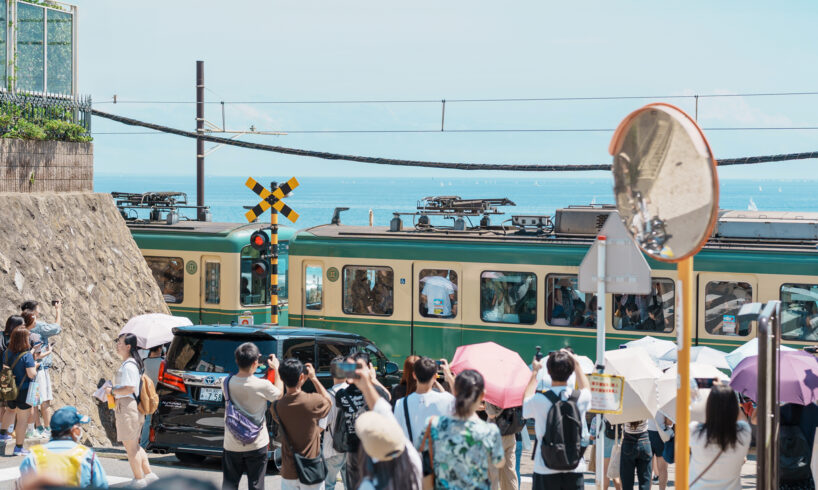
Kamakura, a scenic coastal city near Tokyo, is struggling to cope with an overwhelming flood of tourists. The influx is centered around a railway crossing made famous by the manga and anime series Slam Dunk, located near Kamakura-Koko-Mae Station on the Enoshima Electric Railway Line (known as the Enoden).
The surge of tourists has led to persistent littering and vandalism, pushing the small community to its limit. To address the city’s mounting logistical and financial crisis, the municipal government has resorted to an unusual measure: a crowdfunding campaign to pay for the necessary security staff.
The Crossing near Kamakura-Koko-Mae station as it appears in the Slam Dunk series introduction
The Effects of Overtourism in Kamakura
The immense popularity of the Slam Dunk series has turned the crossing into a must-visit spot, but the resulting overtourism has created severe community strain. Tourists frequently gather — up to 200 people at peak times — spilling into the road to capture photos and creating a safety hazard that forces security staff to constantly intervene.
Beyond the safety risks, the community is dealing with significant behavioral issues. The station’s restrooms, for instance, were closed in late April after repeated vandalism, with improper items being flushed down the toilet. A nearby temple also reported widespread littering and even public urination, including cases where plastic bottles filled with urine were left on the grounds.
As local complaints mount, the city has warned that tougher measures may be needed to protect the community, perhaps even making the scenic spot “less photogenic,” similar to methods adopted by a town near Mt. Fuji to deter crowds.
The Great Buddha of Kamakura at Kotoku-in
Debates Over the Cost of Crowd Control
To maintain order and safety, both the city and the railway line have had to steadily increase security personnel. What started as weekend traffic advice in 2017 escalated to a weekday effort in 2023, and by 2024, it required a dedicated two-person security team. During peak periods, the team temporarily swelled to seven members. Currently, five guides are stationed there.
The bill for these extensive security measures — which have historically been covered by a mix of national subsidies, railway contributions and local tax money — has become a major point of contention.
Local residents are understandably frustrated, arguing that they receive little direct benefit from the tourism boom while their taxpayer funds are diverted to manage it. This frustration has led to suggestions that the railway operator should bear the full financial responsibility.
Kamakura’s Answer: The Furusato Nozei Program
The city also received offers of help from visitors outside Kamakura, prompting the launch of the Furusato Nozei (hometown tax) campaign. The tax offset program was introduced in 2008 to revitalize and rejuvenate less populated areas of Japan, in which city-dwelling taxpayers can “donate” an amount of their residence tax to a regional “hometown.” In return, donors receive gifts from the region, ranging from local produce to artisan crafts.
The campaign’s goal is ambitious: Kamakura hopes to raise ¥3.5 million (around $23,000) by January 7 to cover the costs of hiring additional security staff. It also hopes to add new signage to manage crowd flow.
Unlike typical instances of the Furusato Nozei program, however, this campaign will not offer thank-you gifts in return, which means that its success will depend purely on public awareness and compassion.
Related Posts
Discover Tokyo, Every Week
Get the city’s best stories, under-the-radar spots and exclusive invites delivered straight to your inbox.
Updated On October 21, 2025





